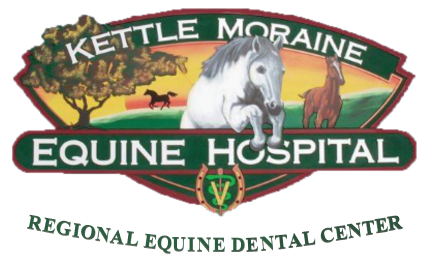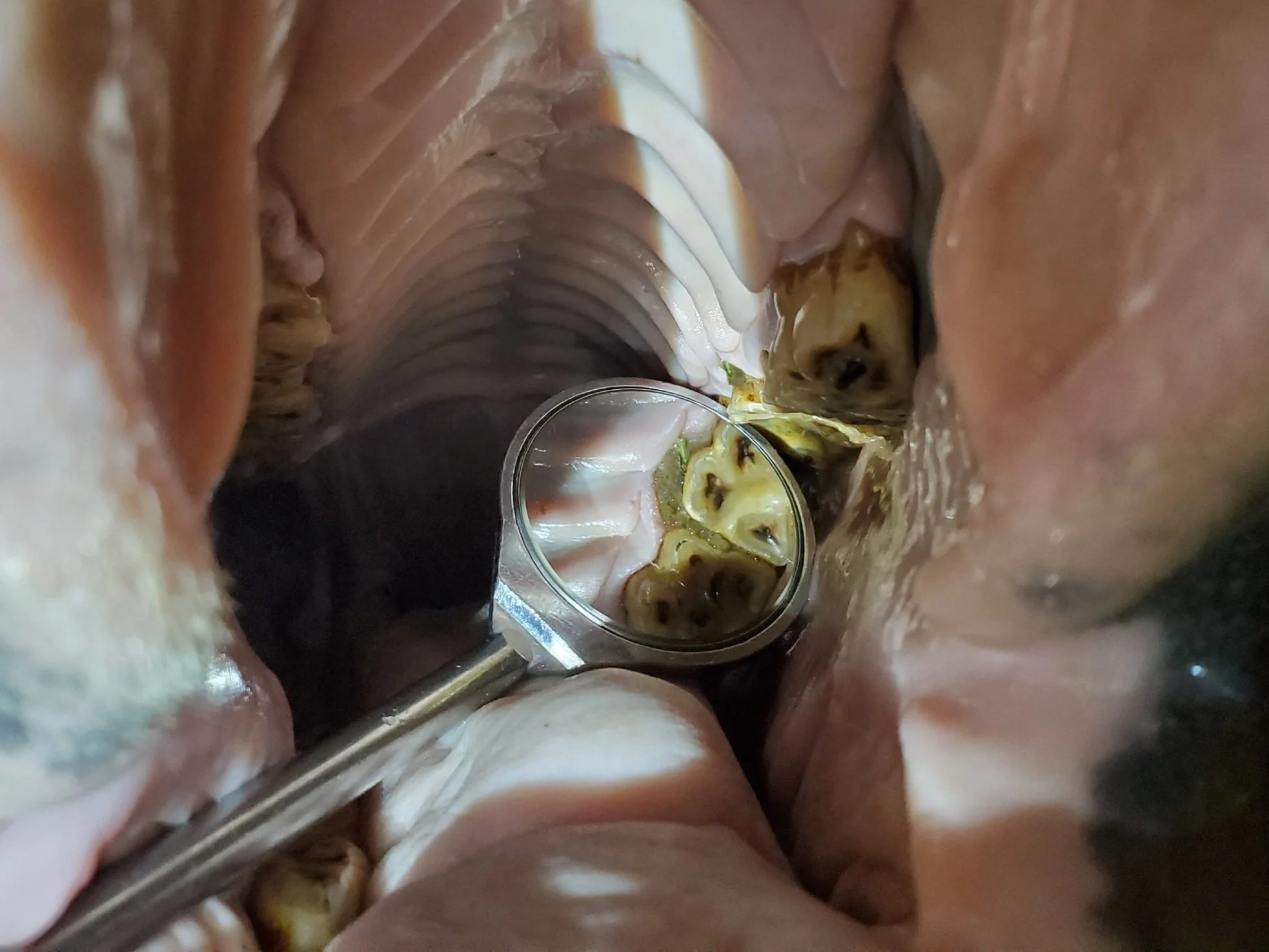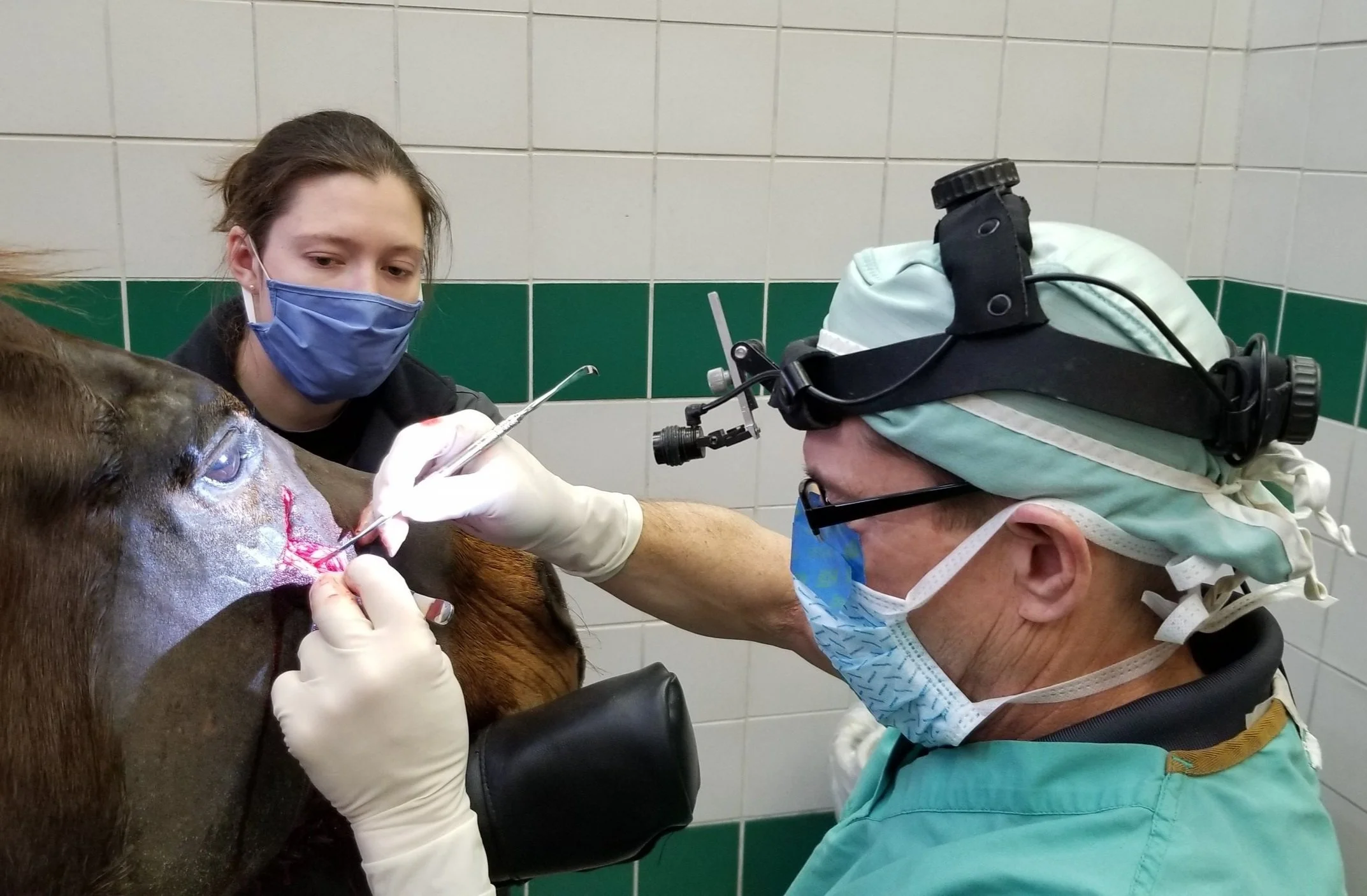Dental Care
Please note that we ask all clients to WITHHOLD FEED from their horse starting ONE HOUR prior to their scheduled dental procedures. Studies have shown this can reduce the risk of colic and other possible risks associated with the sedation required for these scheduled procedures. The risks and benefits are different in emergency cases, but we have control regarding pre-planned procedures and are going to use that to your horse’s advantage!
Kettle Moraine Equine Hospital and Regional Equine Dental Center (KMEH-REDC) offers comprehensive diagnostic and treatment options for equine dentistry. Jon M. Gieche, DVM, FAVD EQ, Diplomate AVDC EQ is the only equine fellow of the Academy of Veterinary Dentistry in the state of Wisconsin. He is also one of only eight equine fellows in the United States of America and one of only sixteen Diplomates of the American Veterinary Dental College Specializing in Equine Dentistry in the country. Although Kettle Moraine Equine Hospital offers an extensive list of services in all areas of equine medicine, dentistry is our specialty, and we see referrals from all over the country. In some special cases, Dr. Jon Gieche is flown across the country or to other countries for cases requiring his expertise. At Kettle Moraine Equine Hospital, you know you are getting the best possible care in Equine Dentistry.
Oral Examination
The oral examination is one of the most important parts of equine dentistry. In order to provide the best dental care for your horse, the veterinarians at KMEH-REDC complete an extensive oral exam and chart all the abnormalities observed. First a history is gathered, followed by an extraoral examination. After your horse is sedated, oral function test measurements are taken. Then a speculum is placed in your horse’s mouth and the veterinarian visually examines the mouth with a mirror and/or oroscope, and palpates the structures in the mouth with their hand and/or dental instruments. From here your veterinarian will decide what needs to be addressed in the oral adjustment and if some abnormalities may require more than one visit to correct. Once the current treatments are completed the speculum is removed and post treatment oral function test measurements are taken.
Oral Adjustment
An oral adjustment (OA) is bringing the dentition into the best functional condition as possible. This may be as simple as removing the sharp enamel points from the cheek teeth (molars and premolars) or it could involve adjusting or correcting abnormalities like waves, stepped teeth, wedge teeth, shear mouths, diagonals, smiles, frowns etc. (primarily type I malocclusions). It should include performing function tests during the initial examination phase and after the OA is completed. It is important not to remove too much dental material from a tooth at one time and treatment plans will often need to be executed over a period of time to prevent patient injury.
Malocclusions
Malocclusions are any deviation from normal occlusion. A tooth is, or multiple teeth are, not in the correct place, or an abnormality preventing the jaw from closing in the correct position or chewing in the normal pattern is present. Malocclusions can originate from the teeth themselves or from asymmetry or an abnormality of the bones associated with the dentition. If identified early, these abnormalities can be addressed and improved to achieve the most functional occlusion possible for the patient. When identified late, treatment often requires a more involved and higher risk approach and may require more frequent oral adjustments. Common malocclusions identified in equids include hooks, ramps, steps, excessive transverse ridges, wave mouth and diagonal bites.
Periodontal Disease Management
Periodontal disease is not uncommon among horses. Roughage in the horses’ diet can collect in diastemas (spaces between teeth) or be packed under the gum line along the teeth. The packed feed allows for excess bacterial growth in the area and can create damage to the attachment tissues of the teeth (periodontal disease). In addition, other conditions like advancing endodontic disease may lead to attachment loss (periodontal disease). By recognizing these signs and completing the required diagnostics, a treatment plan can be developed to prolong the health of both the teeth involved and your horse.
Diagnostics
Digital Radiography is a key diagnostic tool in identification and treatment planning of dental disease, especially when it comes to the early stages of a disease process. Imaging helps us to evaluate the affected and surrounding structures and tailor the best possible treatment plan for your horse.
KMEH has state-of-the-art, specialized digital radiographic equipment allowing us to take both intraoral and extraoral radiographs. The addition of intraoral radiographs provides a means to obtain oral radiographic images of specific oral structures that are difficult to evaluate from extraoral images. Intraoral digital radiographs help eliminate confusing overlapping structures from areas other than the target tissues (teeth, etc.), providing “cleaner” images and allowing for more detailed evaluation of the structure(s) of interest.
Oroscopy is endoscopy of the mouth, or video feed of a camera image from inside the mouth. It is used to obtain detailed images of less accessible portions of a horse’s mouth, such as the back of the mouth, or where the tongue or cheek runs along the teeth. It can also be used to provide detailed, magnified images of the occlusal surface (where the top and bottom teeth pass over each other to grind food) to further investigate suspected abnormalities, such as infundibular cavities. Oroscopy may be recommended as an additional way to examine your horse’s mouth, as a way to increase visibility for completion of delicate intraoral procedures, or as a way to track and record progress of a staged treatment plan or the healing process.
Sinoscopy is an endoscopic exam (camera view) of the sinuses. Horses’ maxillary (upper) teeth are intimately associated with the sinus cavities of the skull (specific teeth are associated with specific sinus cavities). Infections of the maxillary tooth roots can lead to sinus infections (secondary sinusitis), and sinus infections can, in turn, affect the maxillary teeth. Sinoscopy is used to obtain detailed images and information about disease processes that affect the sinus cavities and evaluate for dental involvement. This information helps us determine specific diagnoses and plan surgical procedures and treatment plans.
Dental Extractions
While our goal is to keep your horses’ teeth healthy and in their mouth, sometimes the best way to help your horse and treat their dental disease, is to extract the teeth involved. KMEH-REDC has all the equipment necessary to perform any dental extraction, from simple to complex extractions, of any tooth in the horses’ mouth. This includes special equipment for equids of all different shapes and sizes. The large majority of dental extractions at KMEH-REDC are completed with an intraoral approach in the standing, sedated horse. This decreases the risk to your horse and shortens healing times.
EOTRH Surgery
EOTRH (Equine Odontoclastic Tooth Resorption with Hypercementosis) is a progressive painful disease of primarily the incisor and canine teeth of the horse. It may occur in a number of presentations including: primarily resorptive where the teeth are eaten away over time, hypercementotic where the teeth form excessive amounts of cementin over their surfaces, or a combination of the two. Often the horse will hide its pain very well and as an owner you may not realize your horse is suffering. Tests like the “carrot test” and evaluation of the “grimace response” may be helpful to assess levels of pain. Unfortunately, to date the best treatment for EOTRH is extraction of the affected teeth. This may be an involved surgery requiring an experienced dental surgeon with intimate knowledge of the involved anatomy. Specialized surgical instruments and techniques are employed to achieve the best possible outcomes. These may include raising tissue flaps and removal of bone to reshape the upper and/or lower facial bones. The good news here is that horses generally do extremely well postoperatively and go on to live a happy pain free life. If you or your veterinarian thinks your horse may have EOTRH, please reach out to us for a consultation. We can substantially improve your horse's quality of life.
Sinus Surgeries
Horses have six pairs of paranasal sinuses. When a sinus becomes infected or affected directly it is termed “primary sinusitis or primary sinus disease”. When a sinus becomes infected or affected due to extension of disease from an area outside the sinus it is termed “secondary sinusitis or secondary sinus disease”. There are a number of treatment options for sinus infections depending on the source of the problem. In some cases tubes may be placed under the skin and through the bone into a sinus to allow flushing of the sinus for a few days. In other cases the sinus may need to be opened surgically to allow removal of dead and decaying tissues, cysts, or infected teeth or tooth roots. Masses may form in the sinuses requiring one or more sinuses to be surgically opened to gain access to the mass for safe biopsy or for removal etc.. Horse sinus anatomy is complex and involves a number of critical vessels, nerves and other structures like the thin wall of bone that separates the sinuses from the area housing the brain. Special training and advanced care techniques must be employed when performing sinus surgeries. Being a seasoned clinician and both fellowed by the AVD EQ and boarded by the AVDC EQ gives you confidence Dr. Gieche has the training and expertise needed to perform these challenging sinus procedures.
OTHER Surgeries of the Head/Mass Removals
Not every procedure fits into the categories listed above. KMEH-REDC is well equipped to meet all your equine dental needs. Whether a mass is found in your horse’s mouth, your veterinarian is looking to refer a complicated dental case, or you have any other concern about your horse’s dental health, we are here and ready to help. Just give us a call at (262) 495-2799 so that we can determine how we can best meet your needs.









